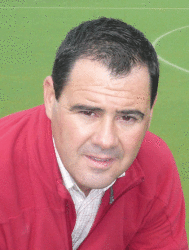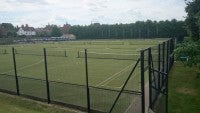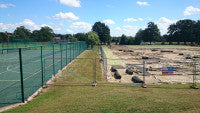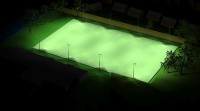Artificial & Synthetic Surfaces; Provision for 'extras'
This article, the fourth in a series prepared by David Rhodes of Traction Sports, looks at the many additional requirements outside the footprint of the playing surface, such as warm-up areas, access, fencing and storage. Together, they can have a significant impact on the budget.

The utilisation of rigid fence systems to encompass and identify a given area for sport can do much to enhance a facility overall, and need not be too invasive on either the landscape or the eye. Sometimes, softer fence schemes can be used to gently encompass an area rather than completely encapsulate it. A good example of this is athletics facilities that do not require masses of rigid fencing, but can be used to manage the natural flow of athletes and create spectator standing areas.
Fencing systems are also used to keep unauthorised users out and keep sports equipment in, e.g. sports and recreation balls. Some fence systems effectively become part of the game, whereby they are used as rebound structures to allow a game to be played in a certain way or within a given dimension. A good example of this is multi-use games areas where the fence system creates the goal recess and the fence design can include rebound properties.

We personally always recommend a standard RAL black, if a steel fence is used. The colour is typically applied as a specialist powder coat and gives the fence additional structural integrity and longevity. We find that galvanised and green fencing systems can be jarring to the eye and black works better when trying to merge a sports facility into a surrounding landscape.
Rigid steel fencing requires specialist manufacture and installation to ensure that the system is fit for purpose and sustainable. There is industry guidance for best practice for fencing systems and many example design layouts are available from the respective sport's governing bodies. We recognise that cost effect alternatives, perhaps in timber or chainlink, are available, but these would ordinarily only be used in specific situations.

Temporary division of areas within the overall footprint can be achieved by the inclusion of divider net systems, but these can be difficult to operate practically speaking.

Sports Floodlighting
Sports schemes can be significantly enhanced by the addition of a floodlighting system that is well designed and utilises contemporary product design and light engineering. We appreciate that floodlighting a sports area may appear to be at conflict with some environmental thinkers and planning principles, but suggest that this whole topic is looked at separately from this article.

Planning authorities will look carefully at light pollution issues and, as such, appropriate external advice may well be needed. As part of the planning and design process, a full evaluation of the available power source, control mechanisms and facility infrastructure should be carried out, and any budget proposals should reflect this additional requirement, if needed.
Access for pedestrians and vehicles

There are a plethora of items to consider, including desire lines, site safety and security and usability, whereby multiple users may be using the site at any one time.
The quality and type of any surface finish will be dependent upon finances, other materials used on site and vehicle types etc. It is important that access path dimensions allow for side by side access, full turning circles and splays, if needed, and make full disabled provision. We find that shadow lighting can really help site movements in the darker winter months, and this would normally be installed from the principal access points around the site.
Training/waiting areas
Depending upon available budgets, supplementary user and spectator facilities can be installed to enhance a facility footprint and make it more user friendly. This means that we tend not to design 'rectangles in fields', and consider carefully how any available space is divided up so that individuals or teams can warm up in a variety of ways before using the main facility. These small, independently sectioned areas, configured from the same materials as the main playing surface, can add real additional value.
These can allow direct access onto the area, but sit adjacent to it, meaning that multiple users can warm up/continue with match play at the same time, and can allow swift transition between areas, optimising income generation of the footprint.
Spectators need to be considered equally and adequate provision be made, normally in the form of standing areas, and possibly shelter and welfare facilities, such as toilets and drinks fountain etc. A word of warning however, we would not generally recommend surfacing a high traffic area such as a spectator area in synthetic grass. Exacerbated contamination and maintenance issues are realised, especially with a small working area which can be narrow and difficult to maintain.
Finally, make plenty of provision for ongoing waste management, including the dreaded chewing gum!
Detox/refreshment points
Cleanliness is definitely next to Godliness when it comes to sports surface maintenance. As such, a detailed consideration should be made of ongoing user, maintenance vehicle and spectator footwear to ensure that contamination, particularly of surfacing systems with voids or infill, is avoided.

We regularly ask for additional sections of synthetic grass to be left on site for general footwear cleaning as well. A similar strategy should be adopted for other surface types, with perhaps the exclusion of the detox grill if regular vehicle access to the area is not required. This may well be the case with smaller areas, such as tennis courts.
A drinks fountain or two would normally be installed for users, with the ability to fill sports bottles, but the environment can influence this decision as they can sometimes be prone to vandalism.
Furniture and storage areas
Quality furniture can really enhance the perception of what a facility offers, and it is becoming more common for bespoke furniture to be ordered, with the organisation livery included on it. In general terms, you do get what you pay for with furniture and, as a facility provider, you must always ensure that any furniture provided meets stringent BS/EN safety standards, where applicable.
We are always amazed at how common it is to find facilities that do not ensure full compliance in this area, as required.

Another consideration to make, especially on multi-use sites, is the ongoing storage of various furniture items, without the hassle of removing completely offsite, and the transportation issues that that may well involve. This is particularly applicable where a footprint is used for several sports or is a satellite facility.
Normally, this is immediately adjacent to the main footprint, with access gates that facilitate easy movement for clumsy furniture, whereby temporary storage is possible. We would advise that the surface choice of this area be something resistant to wheels and sharp objects being dragged over it; usually, this would be an engineered macadam finish. On the odd occasion we are asked to provide covered storage areas, which can be done, this tends to be expensive for the benefit provided.
All in all, serious consideration should be given to the provision of these extras beyond the initial footprint. They can really make a site happen!
In the next article, we will have a detailed look at surfacing systems.
For a more detailed overview of David's career to date, please see issue 59 of Pitchcare magazine.
David Rhodes T: 07711 846722
E: info@tractionsports.co.uk
